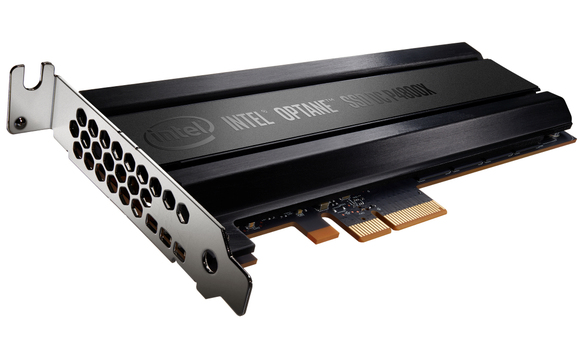This week, Intel officially launched its very first SSD to make use of its new 3D XPoint technology. This tech was first demonstrated back in 2015 and is faster/denser than any other type of memory right now. In all, it is said to be several hundred times faster than the NAND architecture in use today. The first SSD to make use of 3D XPoint is the Optane DC P4800X, which won't necessarily excite consumers with its 375GB of storage, but it could be a game changer for data centres.
The Optane DC P4800X is roughly five to eight times faster than many leading SSDs and should help fill the gap created by DRAM shortages. According to Intel, this drive is particularly ideal for “critical applications with aggressive latency requirements”. This makes sense, as 3D XPoint is built to offer extremely low latency while being built to last.
In terms of read and write speeds, this SSD offers up to 2GB/s over a PCIe connection. It consumes around 14 watts under heavy load, making it very power efficient, another thing that is increasingly important for server farms and data centres.
In all, Intel's $1520 375GB drive offers a combination of high throughput, low latency and high QoS, while being built to endure and alleviate the bottlenecks data centres currently face. In the future, there will be a 750GB version of this available, along with a 375GB model in a U.2 form factor. Eventually. 1.5TB SSDs will also hit the market.
KitGuru Says: This technology is excellent for data centres but won't be of much use to consumers until prices come down and capacities go up. Still, 3D XPoint seems like quite the innovation, though it has hit the market later than initially hoped. What do you guys think of Intel's new 3D XPoint SSD?
 KitGuru KitGuru.net – Tech News | Hardware News | Hardware Reviews | IOS | Mobile | Gaming | Graphics Cards
KitGuru KitGuru.net – Tech News | Hardware News | Hardware Reviews | IOS | Mobile | Gaming | Graphics Cards




Geez this price is insane.
Samsung 950 Pro has 2.5 GB/s read and 1.5 GB/s write but it sure won’t cost 1500 dollars and has more capacity than 375GB.
Remember when SSD first came out. The prices were insane then now look at the prices
Sequential Read, sure. But real life workloads are more geared around Random Reads and Writes at low queue depths. This thing destroys every SSD available in that respect. Which is relevant in low latency transactional databases, etc. On a consumer desktop (measuring boot times, application load times, game load times, etc), this would just show the CPU as the bottle neck.
Somebody has been taking a few pages of the reply repertoire of the likes of Booyaboo2, to be or blah, Ironbunny Ionbunny, Trollmaster etc from the neighbouring site :”) . Plz kindly point me to a server config fitted with Samsung TLC 3DVNAND SSDs then. Last time I checked the professional server jockeys went for at least MLC based SSDs if not straight for SLC SSDs. And those puppies are nowhere nearly as cheap as Samsung’s EVOs and 950 series. Also, if I read and understood correctly Intel still has the option to play the stacking game with the 3DXPoint chips. Give it time; if we’re so quick to pull the trigger on NAND Flash SSDs as some, most notably the S|A shills, would do on 3DXPoint memory, SSDs would have never seen the light of day and we’d be still spinning rust now.
Yes but if you hammer it hard you’ll kill it in 6 months.The whole point of optane is you can can hammer the hell out of it with writes and it’ll deal with it. Theoretically forever. Might not seem significant but if you lose all your work to flash, you never totally trust the damn things ever again. This is in part why data centers avoid flash SSD in mission critical computing environments, instead choosing mechanical hard drive to boot and then loading everything into RAM, and just leaving it there for as long as possible.
It worked great until something happens like filesystem cache kicks in and evicts your mission critical data out of ram into swap, then it takes down an entire rack costing millions of dollars in penalties for service unavailability.
With something like this, you could use this device as swap, then when the operating system does something stupid like fire up slocate and cache the whole goddamn disk in ram for no reason whatsoever, then you evict the data from ram into this device, and the penalty from swapping should be too minor to cause an outage.
At least that was how it worked when i used to work developing mission critical databases for telecoms.
If they made one of these as a sata form factor drive, i’d definitely choose it over a flash based SSD any day of the week. I trust flash about as far as I can throw it. It has built in obsolescence and shouldn’t be used to store valuable data of any kind.
You have to study how flash works really to appreciate why it’s so unreliable. Everytime you write to it, you physically damage it. That’s why it’s only possible to write to flash so many times.
Flash should not be treated as a long term storage solution or used for anything with high write cycles. Unfortunately flash ssds have been sold to the general public as solving both of these problems, and the sad thing is, you wont realise it’s a marketing lie and you’ve been conned until it’s outside of manufacturer warranty.